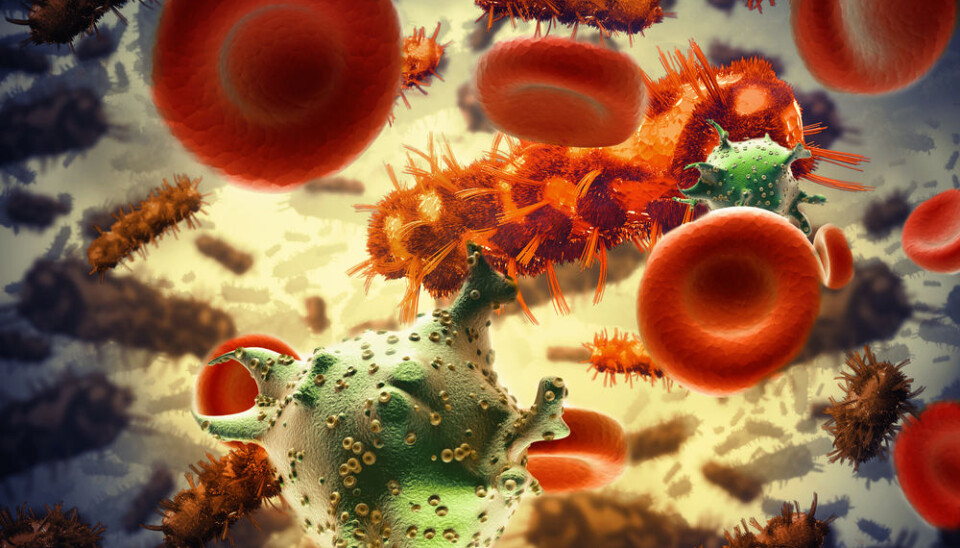
Tolerant bacteria make antibiotics fail
New research project suggests that we need to rethink antibiotic treatment of infections. The bacteria are far better prepared for the doctors’ treatment than we think.
When doctors treat infections with antibiotics, they use naturally occurring substances that the bacteria are likely to be familiar with, albeit at very small doses.
This means that the bacteria are naturally equipped to fight off the antibiotics. They have the ability to quickly make themselves tolerant to antibiotic treatment over short periods or, in the worst case, become permanently resistant.
This leads to problems with failed treatments and stubborn bacteria that are hard to combat.
Scientists at the University of Copenhagen and the Technical University of Denmark are currently addressing this challenge in a new research project, which aims to find out how low concentrations of antibiotics can make bacteria resistant, tolerant or even increase their ability to cause disease.
Our conception of antibiotics may have been too narrow. We have a notion that fungi and other microorganisms have developed antibiotics to kill bacteria. This is probably incorrect. At the low concentrations found in nature, the bacteria do not have much difficulty in surviving the antibiotics.
”Our conception of antibiotics may have been too narrow. We have a notion that fungi and other microorganisms have developed antibiotics to kill bacteria. This is probably incorrect. At the low concentrations found in nature, the bacteria do not have much difficulty in surviving the antibiotics,” says the head of the project, Professor Hanne Ingmer, of the Department of Veterinary Disease Biology at the University of Copenhagen, Denmark.
”At the same time, the mechanisms that bacteria use to resist low concentrations of antibiotics in nature are likely to be the cause of many of the treatment problems we’re seeing today.”
Antibiotics can make people sicker
Ingmer’s research team has conducted a series of experiments that show how bacteria adapt and change when exposed to small quantities of antibiotics. The experiments showed that bacteria that have been exposed to small quantities of antibiotics undergo changes in the production of the proteins that make people ill.
Sometimes this production decreases, which is good for the patient. But the production can also increase, potentially increasing the risk that the patient becomes even sicker as an unwanted side effect of the antibiotic treatment.
This discovery is obviously of great relevance to the way we should treat infections. If the patient has not been given the right amounts of antibiotics, or if the absorption of antibiotics failed in the treatment, our findings may help explain why many patients need to switch to a new antibiotic to fight off a stubborn infection.
”Our experiments with staphylococci show that the production of disease-causing proteins changes when the bacterium is exposed to even very low concentrations of antibiotics,” says Ingmer.
“These concentrations are sometimes so low that they do not affect the growth of the bacteria. If you experience faulty treatment of an infection, it affects the way the bacteria behave, and that can cause people to become sick.”
Bacteria become tolerant but not resistant
Low concentrations of antibiotics can also make the bacteria tolerant and difficult to combat. Another study by the same research team has shown that bacteria can withstand great amounts of antibiotics, provided they have had a small foretaste first.
In other words, if bacteria are exposed to a very low concentration of antibiotics, they become tolerant and harder to kill even with very large amounts of the same antibiotic.
The cause is presumably to be found in an innate survival mechanism in the bacteria, which enables them to prepare for large amounts of antibiotics as soon as they get a whiff of it.
This is the first time that researchers demonstrate that bacteria can develop tolerance to antibiotics without actually becoming resistant.
“We suspect that the tolerance is achieved as a result of physiological changes in the cell that for example may prevent the antibiotics from being absorbed in the bacteria. This is a temporary measure that the bacteria use to protect themselves,” says the professor.
”This discovery is obviously of great relevance to the way we should treat infections. If the patient has not been given the right amounts of antibiotics, or if the absorption of antibiotics failed in the treatment, our findings may help explain why many patients need to switch to a new antibiotic to fight off a stubborn infection.”
The findings also have medical implications, she adds. In order for doctors to be able to provide the best possible treatment of infectious diseases in the future, it is important that the effects of the individual antibiotics on the various bacteria are studied in more detail.
------------------------
Read the Danish version of this article at videnskab.dk
Translated by: Dann Vinther








